Andrei Bursuc
FLOSS: Free Lunch in Open-vocabulary Semantic Segmentation
Apr 14, 2025Abstract:Recent Open-Vocabulary Semantic Segmentation (OVSS) models extend the CLIP model to segmentation while maintaining the use of multiple templates (e.g., a photo of <class>, a sketch of a <class>, etc.) for constructing class-wise averaged text embeddings, acting as a classifier. In this paper, we challenge this status quo and investigate the impact of templates for OVSS. Empirically, we observe that for each class, there exist single-template classifiers significantly outperforming the conventional averaged classifier. We refer to them as class-experts. Given access to unlabeled images and without any training involved, we estimate these experts by leveraging the class-wise prediction entropy of single-template classifiers, selecting as class-wise experts those which yield the lowest entropy. All experts, each specializing in a specific class, collaborate in a newly proposed fusion method to generate more accurate OVSS predictions. Our plug-and-play method, coined FLOSS, is orthogonal and complementary to existing OVSS methods, offering a ''free lunch'' to systematically improve OVSS without labels and additional training. Extensive experiments demonstrate that FLOSS consistently boosts state-of-the-art methods on various OVSS benchmarks. Moreover, the selected expert templates can generalize well from one dataset to others sharing the same semantic categories, yet exhibiting distribution shifts. Additionally, we obtain satisfactory improvements under a low-data regime, where only a few unlabeled images are available. Our code is available at https://github.com/yasserben/FLOSS .
VaViM and VaVAM: Autonomous Driving through Video Generative Modeling
Feb 21, 2025Abstract:We explore the potential of large-scale generative video models for autonomous driving, introducing an open-source auto-regressive video model (VaViM) and its companion video-action model (VaVAM) to investigate how video pre-training transfers to real-world driving. VaViM is a simple auto-regressive video model that predicts frames using spatio-temporal token sequences. We show that it captures the semantics and dynamics of driving scenes. VaVAM, the video-action model, leverages the learned representations of VaViM to generate driving trajectories through imitation learning. Together, the models form a complete perception-to-action pipeline. We evaluate our models in open- and closed-loop driving scenarios, revealing that video-based pre-training holds promise for autonomous driving. Key insights include the semantic richness of the learned representations, the benefits of scaling for video synthesis, and the complex relationship between model size, data, and safety metrics in closed-loop evaluations. We release code and model weights at https://github.com/valeoai/VideoActionModel
DOC-Depth: A novel approach for dense depth ground truth generation
Feb 04, 2025



Abstract:Accurate depth information is essential for many computer vision applications. Yet, no available dataset recording method allows for fully dense accurate depth estimation in a large scale dynamic environment. In this paper, we introduce DOC-Depth, a novel, efficient and easy-to-deploy approach for dense depth generation from any LiDAR sensor. After reconstructing consistent dense 3D environment using LiDAR odometry, we address dynamic objects occlusions automatically thanks to DOC, our state-of-the art dynamic object classification method. Additionally, DOC-Depth is fast and scalable, allowing for the creation of unbounded datasets in terms of size and time. We demonstrate the effectiveness of our approach on the KITTI dataset, improving its density from 16.1% to 71.2% and release this new fully dense depth annotation, to facilitate future research in the domain. We also showcase results using various LiDAR sensors and in multiple environments. All software components are publicly available for the research community.
Domain Adaptation with a Single Vision-Language Embedding
Oct 28, 2024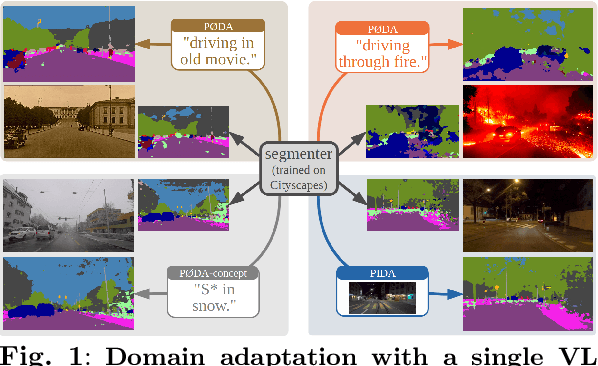


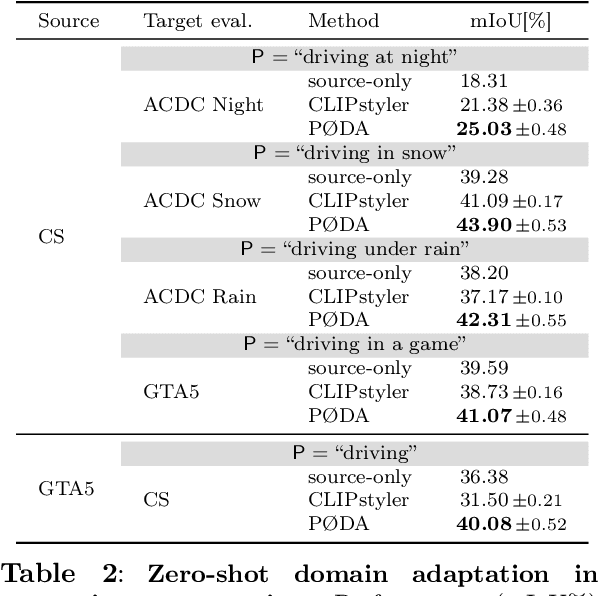
Abstract:Domain adaptation has been extensively investigated in computer vision but still requires access to target data at the training time, which might be difficult to obtain in some uncommon conditions. In this paper, we present a new framework for domain adaptation relying on a single Vision-Language (VL) latent embedding instead of full target data. First, leveraging a contrastive language-image pre-training model (CLIP), we propose prompt/photo-driven instance normalization (PIN). PIN is a feature augmentation method that mines multiple visual styles using a single target VL latent embedding, by optimizing affine transformations of low-level source features. The VL embedding can come from a language prompt describing the target domain, a partially optimized language prompt, or a single unlabeled target image. Second, we show that these mined styles (i.e., augmentations) can be used for zero-shot (i.e., target-free) and one-shot unsupervised domain adaptation. Experiments on semantic segmentation demonstrate the effectiveness of the proposed method, which outperforms relevant baselines in the zero-shot and one-shot settings.
Fine-Tuning CLIP's Last Visual Projector: A Few-Shot Cornucopia
Oct 07, 2024
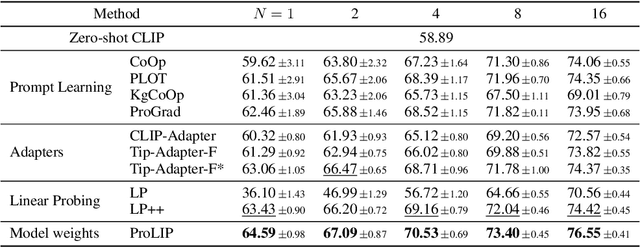

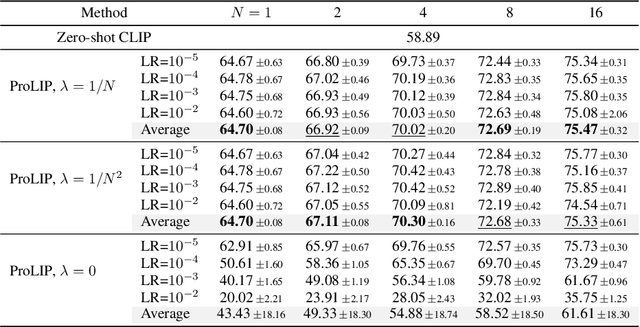
Abstract:We consider the problem of adapting a contrastively pretrained vision-language model like CLIP (Radford et al., 2021) for few-shot classification. The existing literature addresses this problem by learning a linear classifier of the frozen visual features, optimizing word embeddings, or learning external feature adapters. This paper introduces an alternative way for CLIP adaptation without adding 'external' parameters to optimize. We find that simply fine-tuning the last projection matrix of the vision encoder leads to strong performance compared to the existing baselines. Furthermore, we show that regularizing training with the distance between the fine-tuned and pretrained matrices adds reliability for adapting CLIP through this layer. Perhaps surprisingly, this approach, coined ProLIP, yields performances on par or better than state of the art on 11 few-shot classification benchmarks, few-shot domain generalization, cross-dataset transfer and test-time adaptation. Code will be made available at https://github.com/astra-vision/ProLIP .
LED: Light Enhanced Depth Estimation at Night
Sep 12, 2024Abstract:Nighttime camera-based depth estimation is a highly challenging task, especially for autonomous driving applications, where accurate depth perception is essential for ensuring safe navigation. We aim to improve the reliability of perception systems at night time, where models trained on daytime data often fail in the absence of precise but costly LiDAR sensors. In this work, we introduce Light Enhanced Depth (LED), a novel cost-effective approach that significantly improves depth estimation in low-light environments by harnessing a pattern projected by high definition headlights available in modern vehicles. LED leads to significant performance boosts across multiple depth-estimation architectures (encoder-decoder, Adabins, DepthFormer) both on synthetic and real datasets. Furthermore, increased performances beyond illuminated areas reveal a holistic enhancement in scene understanding. Finally, we release the Nighttime Synthetic Drive Dataset, a new synthetic and photo-realistic nighttime dataset, which comprises 49,990 comprehensively annotated images.
No Train, all Gain: Self-Supervised Gradients Improve Deep Frozen Representations
Jul 15, 2024



Abstract:This paper introduces FUNGI, Features from UNsupervised GradIents, a method to enhance the features of vision encoders by leveraging self-supervised gradients. Our method is simple: given any pretrained model, we first compute gradients from various self-supervised objectives for each input. These are projected to a lower dimension and then concatenated with the model's embedding. The resulting features are evaluated on k-nearest neighbor classification over 11 datasets from vision, 5 from natural language processing, and 2 from audio. Across backbones spanning various sizes and pretraining strategies, FUNGI features provide consistent performance improvements over the embeddings. We also show that using FUNGI features can benefit linear classification and image retrieval, and that they significantly improve the retrieval-based in-context scene understanding abilities of pretrained models, for example improving upon DINO by +17% for semantic segmentation - without any training.
A Study of Test-time Contrastive Concepts for Open-world, Open-vocabulary Semantic Segmentation
Jul 06, 2024



Abstract:Recent VLMs, pre-trained on large amounts of image-text pairs to align both modalities, have opened the way to open-vocabulary semantic segmentation. Given an arbitrary set of textual queries, image regions are assigned the closest query in feature space. However, the usual setup expects the user to list all possible visual concepts that may occur in the image, typically all classes of benchmark datasets, that act as negatives to each other. We consider here the more challenging scenario of segmenting a single concept, given a textual prompt and nothing else. To achieve good results, besides contrasting with the generic 'background' text, we study different ways to generate query-specific test-time contrastive textual concepts, which leverage either the distribution of text in the VLM's training set or crafted LLM prompts. We show the relevance of our approach using a new, specific metric.
Valeo4Cast: A Modular Approach to End-to-End Forecasting
Jun 12, 2024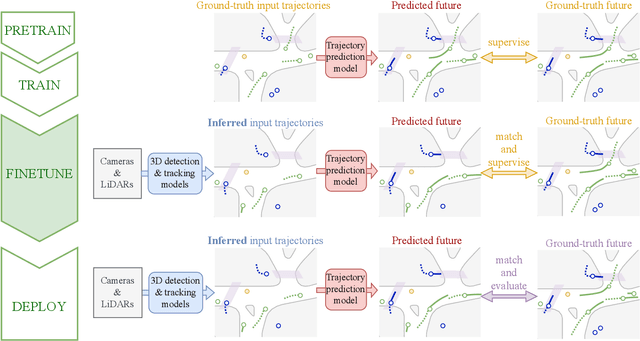
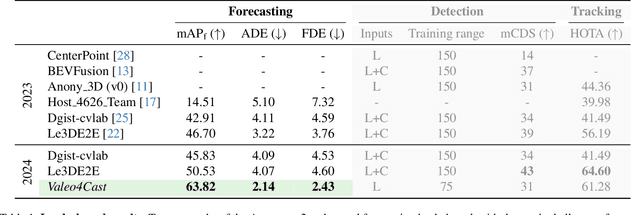
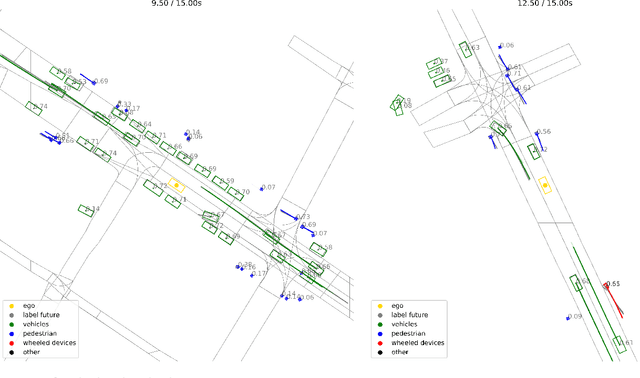
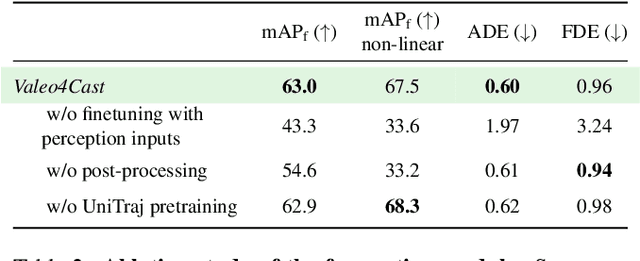
Abstract:Motion forecasting is crucial in autonomous driving systems to anticipate the future trajectories of surrounding agents such as pedestrians, vehicles, and traffic signals. In end-to-end forecasting, the model must jointly detect from sensor data (cameras or LiDARs) the position and past trajectories of the different elements of the scene and predict their future location. We depart from the current trend of tackling this task via end-to-end training from perception to forecasting and we use a modular approach instead. Following a recent study, we individually build and train detection, tracking, and forecasting modules. We then only use consecutive finetuning steps to integrate the modules better and alleviate compounding errors. Our study reveals that this simple yet effective approach significantly improves performance on the end-to-end forecasting benchmark. Consequently, our solution ranks first in the Argoverse 2 end-to-end Forecasting Challenge held at CVPR 2024 Workshop on Autonomous Driving (WAD), with 63.82 mAPf. We surpass forecasting results by +17.1 points over last year's winner and by +13.3 points over this year's runner-up. This remarkable performance in forecasting can be explained by our modular paradigm, which integrates finetuning strategies and significantly outperforms the end-to-end-trained counterparts.
OccFeat: Self-supervised Occupancy Feature Prediction for Pretraining BEV Segmentation Networks
Apr 22, 2024



Abstract:We introduce a self-supervised pretraining method, called OcFeat, for camera-only Bird's-Eye-View (BEV) segmentation networks. With OccFeat, we pretrain a BEV network via occupancy prediction and feature distillation tasks. Occupancy prediction provides a 3D geometric understanding of the scene to the model. However, the geometry learned is class-agnostic. Hence, we add semantic information to the model in the 3D space through distillation from a self-supervised pretrained image foundation model. Models pretrained with our method exhibit improved BEV semantic segmentation performance, particularly in low-data scenarios. Moreover, empirical results affirm the efficacy of integrating feature distillation with 3D occupancy prediction in our pretraining approach.
 Add to Chrome
Add to Chrome Add to Firefox
Add to Firefox Add to Edge
Add to Edge